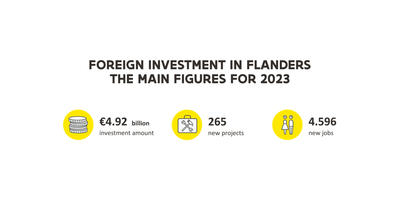
5 open innovation cluster best practices from Flanders

Based on open innovation learnings and cluster internationalization best practices from Flanders Innovation & Entrepreneurship (VLAIO), Flanders Investment & Trade (FIT) and TCI Network, here are five insights to help take clusters to new innovative and international heights.
1. Support and nudge, don't push
Flanders has various clusters in which private, public and academic players unite to innovate for different sectors and strategic domains. What all these clusters have in common is the bottom-up way in which they came into existence. Flanders’ policymakers made the conscious choice to support innovation without being in the driver’s seat. As such, clusters are created at the initiative of the business world.
But this doesn’t mean that governments can’t promote cluster membership by raising awareness of the benefits. For starters, by coming together as clusters, companies receive an easily accessible opportunity to familiarize themselves with open innovation and co-creation. This, in turn, has economic benefits: companies can deliver better financial results in the long run if they decide to expand their core activities in alliance with their competitors. What’s more, being part of a cluster enables companies to explore new and efficient ways of dealing with intellectual property while including the entire value chain in their innovation process.
“Clusters play a crucial role in facilitating and strengthening open innovation and co-creation among their members. In doing so, they catalyze technological improvements as well as societal and economic changes.”
2. Structure follows strategy
When companies choose to work together as a cluster, they often spend a lot of time figuring out which organizational structure and company form will suit the collaboration best. The truth is that you can’t possibly tell from the start. Instead, it’s better to focus on fully developing a cluster’s envisioned activities and strategic mission first – and only after determine its structure and form.
3. Build trust through strategy
When companies – many of which are competitors – unite in innovation clusters, one of the main challenges is to get them to trust each other enough to share data, R&D approaches and other types of knowledge. A clear-cut strategy, mission and vision can help lower the threshold for open innovation. Governments have a crucial part to play in this strategic exercise by assisting companies that wish to form a cluster in identifying common goals and KPIs from the earliest stages of cluster development.
In addition to establishing a common goal, it’s essential to create a shared sense of commitment and engagement. In this respect, Flanders’ clusters only receive government support if the participating companies and organizations pledge to contribute an equal amount of resources. Evenly splitting financial commitments is also a definite must if you want clusters to become self-supporting in the long run.
“Governments can help build and foster trust by assisting companies that wish to form a cluster in identifying common goals and KPIs.”
4. Start local but think global from square one
When it comes to supporting cluster organizations, Flanders has always applied the ‘ink spot strategy’. This means developing strong local clusters first, and only afterwards focusing on internationalizing them. It’s a tried and tested approach, but this doesn’t mean that the international aspects of innovation should be neglected in the earliest stages of a cluster’s development.
Even when the actual internationalization of a cluster isn’t planned until much later, it is essential to already plan this aspect in from the very beginning. This can be achieved, for instance, by carrying out international market or landscape analyses as well as by making the necessary budget projections for international sales.
5. Develop a unique international selling proposition
Finally, it’s important to approach cluster formation in the same way you’d start a new business. The main concern? Developing a unique offering that taps into real industry needs – not just locally, but internationally as well. This is because both competition and innovation opportunities come from all corners of the world in today’s increasingly globalized economy.
In this respect, it is crucial for clusters to determine an internationally unique selling proposition right from the start. After all, the innovation challenges we face locally are interconnected with novel developments happening around the globe.


